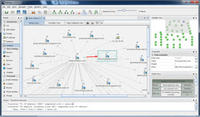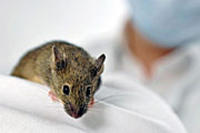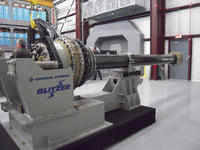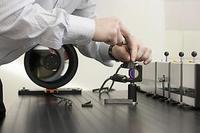-
Looming sequestration causes Navy to looking at future technology, fleet size

Adm. Mark Ferguson, vice chief of naval operations, offered a revealing look at the potential future for the Navy if sequestration, or automatic defense cuts, goes into effect in January; without some sort of adjustment by Congress, currently the subject of discussion on Capitol Hill, the nearly 10 percent across-the-board Department of Defense budget cuts are slated to commence in 2013 and continue for ten years
-
-
Assessing bridge resilience
Across the United States, more than 600,000 bridges link travelers to millions of roadway miles, forming a critical part of the nation’s infrastructure; because bridges are typically more vulnerable than roadways to damage caused by natural and man-made hazards, they are also of interest to DHS, which funds cutting-edge research in various aspects of structural integrity testing and blast-resistant structural design
-
-
Ideas from nature on how to convert solar into liquid fuel
It has long been a dream of scientists to use solar energy to produce chemicals which could be stored and later used to create electricity or fuels; a recent scientific breakthrough is providing hope that this may soon be possible; the development would offer many benefits, including the ability to store chemicals until needed — current solar power technology has difficulties in this area
-
-
Faster data analysis on tactical handheld devices
The Office of Naval Research (ONR) announced a new program to optimize tactical handheld technology for quick decision-making in the field; the Exchange of Actionable Information at the Tactical Edge (EAITE) program, designed to sift through data from multiple sources for faster analysis
-
-
Analyzing the sound of rain falling on a bridge reveals bridge’s health, stability

Engineers have found that by listening to how a highway bridge sings in the rain, they can determine serious flaws in the structure; employing a method called impact-echo testing, engineers can diagnose the health of a bridge’s deck based on the acoustic footprint produced by a little bit of water
-
-
New app uses scattered public information to put together a digital footprint of individuals, organizations

A new app application can collect scattered online clues to provide a picture of individuals or organizations; the application draws on public data sources in order to put together a graphical digital footprint
-
-
New military apparel repels chemical, biological agents
Scientists are developing a new military uniform material that repels chemical and biological agents using a novel carbon nanotube fabric; the material will be designed to undergo a rapid transition from a breathable state to a protective state; the highly breathable membranes would have pores made of a few-nanometer-wide vertically aligned carbon nanotubes that are surface modified with a chemical warfare agent-responsive functional layer
-
-
Different technologies aim to replace dogs as explosives detectors
Bomb-sniffing dogs are the best and most popular way for airport security quickly to detect anyone planning to bring explosives to an airport; scientists are trying to change that; Dr. Denis Spitzer and his colleagues, for example, are working on a sensor that will detect vapors of TNT and other explosives in very faint amounts; the device they are trying to create would replace dogs as the top bomb detecting method in the field
-
-
DARPA seeking tools for identifying hidden explosives at standoff
The threat to U.S. soldiers from improvised explosive devices (IEDs) is as varied as the makers of IEDs are resourceful in how they design and conceal the explosives; interdisciplinary teams needed to develop proof-of-concept demonstrations of technology for identifying presence of embedded explosives in opaque, high-water-content substances
-
-
Mice genetically modified to detect landmines

In another advancement in explosives detection, scientists have genetically modified mice to enable them to sniff out landmines; the GM mouse, known as MouSensor, may one day become a significant tool to help deal with the dangerous legacies of past wars
-
-
Rehabilitating historical structures using laser scanning technology
The Carmel Mission Basilica in California is undergoing a restoration using cutting-edge laser scanning technology; earlier this year, engineers the from Blach Construction Company teamed up with CyArk, a non-profit foundation that digitally preserves historical sites, to shoot laser beams at and within the basilica to create precise digital maps of the building from different angles
-
-
New approach to identifying remains allows reopening of cold cases
In an effort to identify the thousands of John/Jane Doe cold cases in the United States, researchers have found a multidisciplinary approach to identifying the remains of missing persons; using the new method, the researchers were able to identify the remains of a missing child forty-one years after the discovery of the body
-
-
U.S. Navy tests the second of two railgun prototypes

The EM Railgun launcher is a long-range naval weapon that fires projectiles using electricity instead of traditional gun propellants such as explosive chemicals; magnetic fields created by high electrical currents accelerate a sliding metal conductor, or armature, between two rails to launch projectiles at 4,500-5,600 mph; the Office of Naval Research’s Electromagnetic (EM) Railgun program is evaluating the second of two industry railgun prototype launchers at a facility in Dahlgren, Virginia
-
-
Green laser pointer identifies traces of dangerous chemicals in real time

By using an ordinary green laser pointer, the kind commonly found in offices and college lecture halls, an Israeli research team has developed a new and portable Raman spectrometer which can detect minute traces of hazardous chemicals in real time; the new sensor’s compact design makes it a candidate for rapid field deployment to disaster zones and areas with security concerns
-
-
Imagining first responders’ high-tech future
What kinds of gear will be needed by future firefighters, EMTs, and police officers? DHS Science and Technology Directorate researchers asked the experts, then applied sophisticated math to discover unlikely patterns
-
More headlines
The long view
New Technology is Keeping the Skies Safe
DHS S&T Baggage, Cargo, and People Screening (BCP) Program develops state-of-the-art screening solutions to help secure airspace, communities, and borders
Factories First: Winning the Drone War Before It Starts
Wars are won by factories before they are won on the battlefield,Martin C. Feldmann writes, noting that the United States lacks the manufacturing depth for the coming drone age. Rectifying this situation “will take far more than procurement tweaks,” Feldmann writes. “It demands a national-level, wartime-scale industrial mobilization.”
How Artificial General Intelligence Could Affect the Rise and Fall of Nations
By Barry Pavel et al.
Visions for potential AGI futures: A new report from RAND aims to stimulate thinking among policymakers about possible impacts of the development of artificial general intelligence (AGI) on geopolitics and the world order.
Keeping the Lights on with Nuclear Waste: Radiochemistry Transforms Nuclear Waste into Strategic Materials
By John Domol
How UNLV radiochemistry is pioneering the future of energy in the Southwest by salvaging strategic materials from nuclear dumps –and making it safe.
Model Predicts Long-Term Effects of Nuclear Waste on Underground Disposal Systems
By Zach Winn
The simulations matched results from an underground lab experiment in Switzerland, suggesting modeling could be used to validate the safety of nuclear disposal sites.
